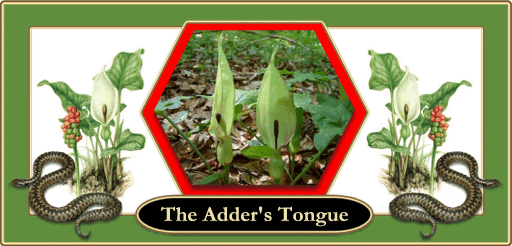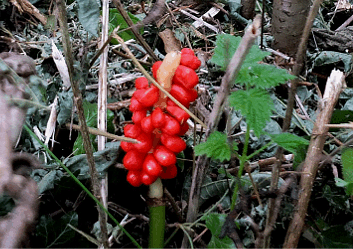
“Even amidst that neglected dike the arum rises in humble state : most curiously shrouded in her leafy tabernacle, and surrounded with luxuriant families, each distinguished by a peculiar livery of green“.
Walk down any hedgerow or stroll through any wood and the chances are that somewhere the shy Adder’s Tongue will be nestled under the undergrowth. The Adder’s Tongue, now there’s a name to conjure with, and it’s only one of many Dartmoor names this plant goes under. You could have Dog’s Dibble, Parson-in-the-Pulpit, Lords and Ladies, Starch Wort, Cuckoo Pint (pronounced as in ‘mint’), Snakes Food or as it is also known the Wild Arum or Arum Lily.
Many of the above names come from the shape of the plant insomuch as the flowers are carried on an erect purple spadix (hence the name Dog’s Dibble) which is sheathed within a green leaf-like hood called a spathe. The spadix exudes what only can be described as one of the foulest scents of the hedgerow and smells very much like putrid flesh. For some reason small rodents such as mice and voles love the taste of the spadix and often you can see where they have been nibbling chunks off. In July the crimson red berries appear as the spathe dies off and shrivels away. Needless to say these are poisonous and can be fatal if eaten by children which is why the name Adder’s Tongue came into use. It is thought that to keep children away from the plant, parents invented the story that adders got the poison for their ‘sting’ from eating the plant. So it was always best to avoid the Adder’s Tongue just in case there was a snake lurking in the nearby undergrowth. The other name; Lords and Ladies and Starch Wort appears to have derived from the fact that in Elizabethan times the fashionable ruffs and collars worn by the upper classes were stiffened by a starch made from the roots of the plant. The only problem with this was that the root extract is highly irritant and often caused blisters on the hands of those unfortunate enough to have to starch the ruffs and collars. It must have also been very uncomfortable for those who actually wore the starched items. The other common name is Cuckoo Pint and this is thought to have originated in Medieval times when it was ‘Cuckold Pint’. The definition of cuckold was a man whose wife had been unfaithful and so the name is meant to have some sexual connotation. An alternative explanation was that there is always a small amount of water to be found in the bottom of the leaf sheath and this was meant to be drunk by cuckoos, hence cuckoo pint. The roots were also used to treat rheumatic pains as the mixture was a stimulant that encouraged profuse sweating. The roots must only be harvested after the leaves have died away and then they must be crushed and dried to make a powder. Strangely enough in the harsh winters of yesteryear it was known that thrushes would dig out the roots, presumably to get to the starch. This starch when thoroughly dried and roasted was used in kitchens as a flour much the same as arrowroot, it was also good for thickening sauces.

It has been said that any young man who placed apiece of Adder’s Tongue leaf in his shoe and recited: “I place you in my shoe, Let all young girls be drawn to you“. would be guaranteed numerous partners at any dance he should attend. In the Moretonhampstead area it was believed that should any young girl touch the plant then she would become pregnant, this probably stems back to the phallic appearance of the spadix. In a similar light the Adder’s Tongue was said to be an aphrodisiac, again because of its erotic spadix but as to which parts of the plant one should eat is anybodies guess?
 Legendary Dartmoor The many aspects past and present of Dartmoor
Legendary Dartmoor The many aspects past and present of Dartmoor

One comment
Pingback: ¿Es raro el helecho de lengua de víbora? - Gardenun